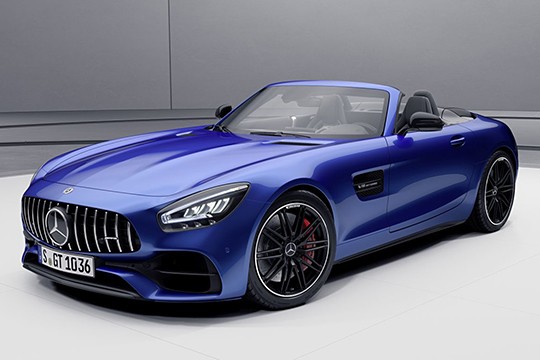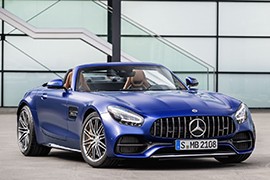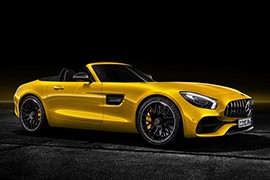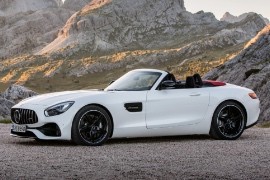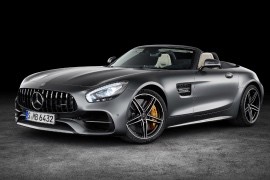MERCEDES-AMG GT Roadster Models/Series Timeline, Specifications & Photos
First production year: 2016
Engines: Gasoline,
While the AMG GT Coupe was more of a daily-driver supercar, its open-top brother was more of a GT with high performances.
In 2014, AMG launched its first product that was named AMG instead of Mercedes-Benz AMG. It was a car like no other in the Mercedes-Benz manufacturer lineup. The supercar was offered with the most powerful naturally aspirated engine on the market at its launch. In 2016 came the first facelift and the convertible version, and four years later, a new refresh for the lineup was introduced.
The 2020 model featured some exterior changes to enhance the look and the car's aerodynamic. The full-LED headlights became a standard feature, and a new grille design was installed. The front bumper was divided into three main areas: the lower grille and the side-intakes. The latter was split in two by a horizontal slat. The car's back was slightly improved, but the four exhaust pipes were left visible, poking out through the rear apron.
The interior featured a carbon-fiber trim on the center console and the dashboard. The instrument cluster was entirely digital, with a 12.3" TFT color-display. An additional screen was placed on top of the center stack for the infotainment system. It was controlled via voice commands, a touch-pad, or via the 10.3" touch-screen. The Apple CarPlay and the Android Auto integration was fitted as standard.
The 2020 AMG GT featured a twin-turbo V8 engine that offered 469 hp. The GT C variant received 550 hp, and the top-spec GT R and GT R Pro received the 577 hp unit. All versions were paired to a 7-speed, dual-clutch, automatic transmission. Power went to the rear wheels, and the gearbox was mounted in the back.
Mercedes-AMG made the GT R Roadster in just 750 units and offered the performance of a racing car combined with the luxury of a grand tourer that could be driven with its top down.
The German sportscar manufacturer introduced the first generation of the GT Coupe in 2014 and refreshed it in 2017. At the same time with the facelifted model, it also unveiled the GT R Coupe and the GT C Roadster. Strangely, it took them another two years until someone from their HQ realized they could mate the race-oriented underpinnings of the R with the open-top of the C Roadster. As a result, in 2019, Mercedes-AMG released the limited-production GT R Roadster. Even if chopping the roof added about 80 kilos (176 lbs.) to the weight of its coupe sibling, performance was still there thanks to the potent twin-turbo V8 under the hood.
When Mercedes-AMG developed the R version of the GT, it had to make it wider to accommodate the improved suspension elements that helped the car withstand higher cornering speeds. As a result, the GT R Roadster was also wider than its GT C open-top sibling. Its front fascia sported the specific Panamericana grille with chromed vertical slats that adorned it. In addition, the lower bumper featured an A-shaped lower air intake in the apron and was flanked by a set of functional side scoops. The enhanced headlights sported LED daytime running lights that looked like arrows pointing toward the three-pointed star badge from the grille.
From its profile, there were a few elements that immediately caught attention. Behind the front wheel wells, the automaker added extracting vents with piano-black trims and chromed V8 Biturbo badges. Versions fitted with the optional carbon-ceramic rotors sported yellow brake calipers that peaked behind the multi-spoke alloy wheels (19" up front and 20" out back). Customers could also opt for a roll-cage, which improved the roadster's stiffness and added a race-car feel. At the back, on the trunk lid, Mercedes-AMG added a functional, adjustable carbon fiber wing that improved downforce. For the rear fascia, the car manufacturer opted for a center-mounted twin exhaust integrated into the diffuser, placed underneath the bumper.
But customers needed to be treated well by the car's interior. As a result, Mercedes-AMG created a luxurious interior fitted with a pair of high-bolstered seats separated by a wide center console that housed the controls for the MBUX infotainment system and the gear selector. On the center stack, the car manufacturer placed four vents, and above them was the multimedia unit screen. The driver fronted a flat-bottom steering wheel wrapped in Alcantara and a pair of paddle shifters behind it. On the digital dashboard, the automaker displayed the speedometer inside the tachometer and was flanked by other information provided by the car's onboard computer on additional screens.
Sharing its underpinnings with the AMG GT R meant that the car was powered by a V8 engine, helped by a pair of turbochargers placed between the cylinder banks, in a Hot-V configuration. The powerplant was paired with a seven-speed automatic (dual-clutch) gearbox that sent the power to the rear wheels. Like its coupe sibling, the R Roadster featured adaptive suspension and four-wheel steering, drastically improving the car's ride and handling.
Mercedes-AMG GT R Roadster (R190) 4.0L V8 Turbo 7AT (585 HP)
After it launched the AMG GT, its marketing department thought that it would be a good idea to chop the roof and make it a roadster. But not just any roadster. So they made it look mean. This is the 2018 AMG GT C Roadster.
It is wider than the GT S and with the 2018 updates, it has the AMG DYNAMICS integrated driving control system for added agility. The rear wheel arches are wider and new side-sills appeared to create a nicer side look. The soft-top is going down electrically in less than 12 seconds at speeds of up to 48 kph (30 mph).
On the AMG GT C the steering wheel comes standard with a rim in black Nappa leather / DINAMICA microfiber. It's all about the grip on the fast curves. As in the AMG GT 4-Door Coupe, the new telematics architecture in the two-door AMG GT models makes the innovative, standard fully digital instrument display with a 12.3-inch instrument cluster and a 10.25-inch multimedia display on the center console possible. The instrument cluster offers a new screen design with the three styles "Classic," "Sporty" or "Supersport."
Both seats are benefiting from the Airscarf feature that blows warm air from behind the backseat, to the neck area, so the occupants will not suffer some sort of sour after a relaxed (or fast) drive. One thing it is hard to understand is why did it have 6 air-vents in the dashboard? They are spoiling the look.
Mercedes-AMG engineers worked around the clock to refresh the S-version for the GT lineup in both shapes, the coupe, and the roadster, and the result was unveiled in 2018.
After creating the SLS supercar, the German carmaker introduced the GT model as a true Grand Tourer. But it wasn't just about long relaxing drives, especially in the S-version. The rag-top version was a true roadster, able to keep up with the most powerful supercars on the market but still offered a touch of luxury.
At the front, the carmaker re-designed the Panamericana grille with vertical slats. It was inspired by the original Mercedes-Benz "Gullwing" from the '50s, just shinier. AMG installed an active aerodynamic system at the bottom of the bumper to help heat up or cool the radiator. On the side, a pair of big vents extracted the hot air from the engine bay. Its canvas-roof was fully retractable behind the seats, at the touch of a button.
Inside, the big center console kept that special design with eight buttons installed on a large V-shaped design. Of course, it corresponded to the V8 engine idea. The carmaker offered an Artico man-made leather/Dinamica microfiber as standard, while Nappa leather was on the options list. A set of AMG Performance, high-bolstered seats were available at extra costs. All S-versions featured a standard Silver Chrome interior package.
The 2018 GT S, either coupe or roadster, gained some extra power. Its 4.0-liter bi-turbo engine provided 522 hp, good enough to rocket the two-seat roadster at speeds over 300 kph (186 mph).
One year after the introduction of the Mercedes-AMG GT coupe, the German automaker unveiled the open-top version of this, named GT Roadster.
Built on the same platform as its closed-cabin sibling, the GT Roadster was available in a few versions, but this one was the entry-level variant. A vehicle that was more of a GT and less of a sportscar. Still, its turbocharged engine and its performance showed that the brand was committed to taking a bigger chunk of the sportscar market. In addition, it boasted enough comfort features to be considered a continental cruiser.
Drawing its inspiration from the famous 300 SL "Gullwing" from the '50s, the AMG GT and its open-top sibling featured a long and low hood. Its Panamericana grille was flanked by swept-back headlights that featured boomerang-shaped LED daytime running lights pointing inwards. To further emphasize the connection with its famous predecessor, the GT Roadster featured a pair of vents on the front fenders adorned by the chromed V8 Biturbo lettering. The slightly ascending beltline started to descend behind the area where the retractable canvas roof was housed, onto the rounded rear end.
Inside, there was room for two people seated in high-bolstered seats. These were divided by a tall center console where the automaker installed the gear selector and the COMMAND infotainment system controls. Like most open-top Mercedes-Benz cars, the AMG GT Roadster featured the Airscarf system that blew warm air to the neck of the occupants.
Powering this heavy, open-top roadster was a hand-built 4.0-liter V8 boosted by a pair of superchargers mounted inside the cylinder banks. All the grunt was sent to the rear wheels via a dual-clutch seven-speed automatic gearbox (AMG SPEEDSHIFT).
In 2016, Mercedes-AMG improved its roadster lineup with a version that sat between the base GT and the top performer GT R.
When Mercedes-Benz decided to transform the AMG into a separate brand, it allowed it to make different models, which didn't have any shape in common with other Mercedes vehicles. The first model introduced under the new brand was the SLS AMG in 2010, while the GT made its appearance in 2014 at the Paris Motor Show. The carmaker improved it and, in 2016, it came with the GT C and GT C Roadster.
Mercedes-AMG unveiled both vehicles in October at the Paris Motor Show. The roadster sported a Panamericana grille with vertical slats and an oversized front bumper that sported an A-shaped lower grille and a pair of side-pods. The carmaker installed a set of vents that extracted the air from the front wheel-wells on the front fenders. Its retractable roof was power-operated, and the driver could open or close the car at speed up to 50 kph (35 mph).
Inside, Mercedes-AMG was a mix of luxury and sport-inspired elements. Its sport-bucket seats with high bolstering. Their integrated headrests featured AirScarf function that blew warm air into the occupant's necks. The satin aluminum trims covered the top of the center console. There were eight buttons for various vehicle settings, including the start/stop button, which was marked with red letterings.
Under the hood, AMG installed the new 4.0-liter V8 biturbo engine paired to a seven-speed automatic (dual-clutch) gearbox. The adaptive suspension featured various settings to improve the car's cornering speed or provide a comfortable ride.
